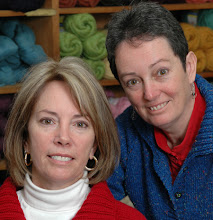
When you knit a cardigan top down you have 5 sections to the sweater - 2 Fronts, 2 sleeves, 1 Back. And if you want to work a 2 stitch pattern repeat - K1, P1 - it's important at the front edges next to the buttonbands that the pattern be symmetrical. So you really work P1, repeat [K1, P1] to end, beginning with a purl and ending with a purl. Usually the odd stitch would be in the centre Back. But this becomes a nightmare to write up.
Slightly simplified here it would go like this: Front: work [P1, K1] to marker// Sleeve: work [P1, K1]// Back: work [P1, K1] end with a P1 (Back has an odd no. of sts)// second Sleeve sequence is worked opposite: work [K1, P1]// work Front: work [K1, P1]. OK not bad.
When you look across the sections you had 2 Fronts and 2 sleeves with an even no. of stitches, and 1 Back with an odd no. of stitches. Now if we work an Increase Row, the Sleeves and Back increase by 2 sts each, but the Fronts only increase by 1 stitch. So now we have 2 Fronts with an odd no. of sts, 2 sleeves with even no. of stitches, and the Back with odd no. of sts.
So now the sequence is: Front begins with P1, work [K1, P1]//sleeve work [K1, P1]//Back begins with [K1, P1], ends with K1//sleeve work [P1, K1]//Front work [P1, K1], ends with P1.
Then add in several sizes and some Short Row shaping and it's getting complicated. I'm trying to simplify. So what I did was move the odd stitch from the centre Back to the second Front. I know, I know, now it's not symmetrical. One of the Fronts has 1 more stitch. But look how easy it becomes when the Front, sleeve, Back, & sleeve are all even numbers. Every section is worked [P1, K1], then the second Front begins with [P1, K1] like the other sections and ends with P1 (odd no. sts). Perfect right? Well except for the symmetrical thing. After working an increase row the first Front becomes odd and the second Front is even. So you work: Front begins with P1, work [K1, P1] (0dd no. sts), and then all the other sections are worked [K1, P1], and the second Front will end with a P1 naturally. Lovely.
To tell you the truth the non-symmetrical thing would bug the *&^%* out of me and I would try to do it so it was symmetrical and get into all kinds of trouble and then figure out that maybe the designer was trying to do me a favour and make the whole thing easier for me to work. So I put in this Note: To make the executing the pattern easier both sleeves, the Back and one of the Fronts have an even number of stitches. The other Front will have an odd number of stitches in order to make the pattern come out properly at front bands. This is obviously not a very good explanation but I hope to indicate that it was all done on purpose to make things easier.
It's a lovely sweater to knit and looks great when finished.
My question is am I setting myself up here to get a barrage of questions and should I be packing my bags to leave the country to get away from the ringing of the phone. Symmetry is a big deal and not to be trifled with.
- Deb


Hi Deb! I think that explanation would be fine. Make sure it's very visible though, right up front in big red letters or something! I know I tend to blunder along reading afterward what I should have read before beginning. :O) Great sweater! samm
ReplyDelete